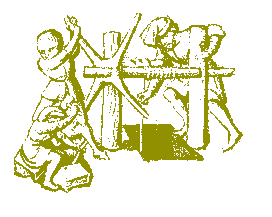| SOME NOTES ON MEDIEVAL ENGLISH GENEALOGY | ||||
| HOME | GUIDE | SOURCES | FAMILIES | RESOURCES |
| LINKS | CALENDAR |
Request updates WHAT'S NEW |
THIS SITE | SEARCH |

The funeral monument is another example of a mainstay of modern genealogy which in fact stretches back well into the medieval period. Though the surviving monuments commemorate a much more restricted section of society, and - in most respects - convey less information than their modern counterparts, they remain a very useful source, and are certainly among the most decorative types of genealogical evidence our ancestors left behind.
The surviving medieval monuments commemorate, broadly, those holding manors - or, at least, substantial estates - together with the occasional priest, merchant or lawyer of similar social status. Fortunately, in medieval times, the custom was for the well-to-do to be buried in the church, not in the churchyard. Their monuments were therefore free at least from the ravages of the elements, and could in principle be expected to survive for hundreds of years. In practice, they were subjected to nearly every other form of destruction imaginable - damp, fire, theft, trampling, vandalism, puritan iconoclasm and sale for scrap metal. Even less durable were the monuments of those who chose to be buried in a favoured religious house instead of the parish church, except in the few which escaped destruction at the hands of Henry VIII. Nevertheless, many monuments remain, and many others were recorded before they perished.
Different kinds of monuments were popular at different times. The commonest types were incised stone slabs, carved stone effigies and monumental brasses. Other types, such as wooden effigies or painted wooden boards, have understandably survived less well. This section primarily treats monumental brasses, which predominate in the late medieval period, and have been most extensively studied and published. However, many of the features described are common to the other types as well.
A late-medieval monumental brass generally consists of several separate components inlaid in a single stone slab. Typically, a family group is depicted, with separate figures for the husband, the wife (or wives), the sons and the daughters. The inscription is usually on a rectangular plate below the figures (or on a strip around the edge). Other common components include coats of arms, religious emblems and scrolls with biblical texts.
The inscription, in Latin - or occasionally French - until about the end of the 15th century, will usually give at least the names of those commemorated and their dates of death, often with an exhortation to the reader to pray for their souls. The inscription will often state the rank (e.g. knight or esquire) of the husband, and may mention a place of residence (e.g. a manor within the parish) and other information, such as a public office held, or a chapel founded by him. In some cases, the wife's father will be named, particularly if she is an heiress. If there are coats of arms on the monument, they may also give clues to her identity. Occasionally children may be named; this is more likely for the elaborate Tudor 'altar tombs', where the children's marriages may also be indicated heraldically.
Sadly, it is comparatively rare to find a monumental brass complete in all respects. One aspect of the inscription which may, unfortunately, be incomplete is the date of death - brasses were often made in the lifetimes of the people depicted, in which case the dates of death would be left to be engraved later. Quite often this was never done. The omission can be particularly misleading in the era of Roman numerals, when a 'provisional' date such as mcccc (for 1400) can be mistaken as the actual date of death, despite the fact that it should have been completed with, for example, lxxiv (to make 1474).
More seriously, some of the brass plates may be missing. The greatest losses, in terms of information, are the groups of children, the coats of arms, and the inscription itself. However, even if the inscription is missing, not all is necessarily lost. Rapidly changing fashions are not an invention of the 20th century. Men's armour and women's costume evolved rapidly, and this evolution has been extensively studied, with the help of brasses and other evidence. As a result, monuments can be dated surprisingly closely on stylistic grounds alone. In a small parish, this often means that there is only one plausible candidate for the ownership of an inscriptionless brass.
At worst, the brass may have been totally lost, perhaps leaving a tantalising 'ghost', or indent behind on the slab. Nevertheless, the evidence may well have been recorded in the past. Transcripts of many lost monumental inscriptions are included in the visitations of the more enlightened heralds, and in the 'church notes' of the industrious antiquaries of the 17th and 18th centuries. The latter may have been published by one of the local historical societies, or have found their way into one of the older county histories. One particularly useful collection is John Weever's Ancient Funerall Monuments, published in 1631, which records the inscriptions - though rarely other details - from many monuments since lost.
For general information about monumental brasses, see the Monumental Brass Society web site. It includes:
As well as the following, many county collections of monumental brasses have been published:
| Church records > |